| |
| |
| Local Attractions |
| |
| Inspite of this there are various colourful temples , which reflect the culture of Jammu, adds attraction for the visitor. The Bahu Fort,Maa-Kali Temple gives an overview of the rich past of the region and on the other hand there are caves that have been established to preserve the ancient art, cultures and traditions. |
| |
 |
BAHU FORT, MAA KALI TEMPLE :5 kms from Jammu city. Situated on a rock face on the left bank of the river Tawi, This is perhaps the oldest fort and edifice in the city. Constructed originally by Raja Bahulochan over 3,000 years ago, the existing Fort was more recently improved and built by Dogra rulers. There is a temple dedicated to Goddess Kali inside the fort popularly known as Bave wali Mata.The fort overlooks river placidly down the Jammu city. Bave Wali Mata is the presiding deity of Jammu.
One can really imagine; on looking at the fort; the wars fought, the invasions prevented and even the grandeur of the Royal families. Today the fort is surrounded with beautiful terraced garden which is favourite picnic spot of the city folk. It has waterfalls, flowers and big trees.Originally built by Raja Jambulochanabout 3,000 years ago, this fort was afterwards renovated and extended by rulers of the Dogra dynasty. 5 kms away from the central part of the city |
|
| |
BAGH-E-BAHU GARDENS/AQUARIUM : Aquarium Bagh-e-Bahu is a must visit place for nature lovers. This beautiful garden with its glittering waterfalls, artificial lake, lush green lawns, flower beds, fountains and big trees is a favourite picnic spot of the city folk and it also has a pleasant view of the city.The subcontinent's largest underground aquarium in Jammu's Bagh-I-Bahu area is drawing a large number of tourists ever since it was opened to the public. the aquarium has become a centre of attraction for tourists, giving them an opportunity to revel in the exotic aquatic world.
The aquarium has attracted large number of tourists visiting the State. The aquarium-cum-awareness centre comprises of 24 aquarium caves including 13 small caves for holding freshwater fishes, two large caves for holding marine water fishes and nine medium sized aquariums for holding marine and fresh water fishes. The entrance is designed in the shape of the mouth of a fish and the exit in the shape of a fish tail.
|
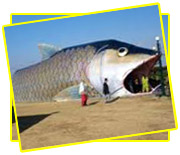 |
|
| |
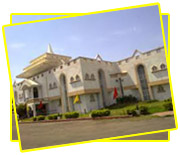 |
KALA KENDRA: Kala kendra Jammu houses a collection of different art products mainly painting and sculpture by many Indian artists. A visit to the kala Kendra gives us an overview of the mediaeval and contemporary Indian art.
The building that has been created to house kala Kendra has a very visually appealing architecture. The architectural plan has been conceptualized like a classic Indian palace and it has a radiant white colour, which diffuses the sunlight falling on it in an excellent manner.
The formation of the kala Kendra has a two-fold purpose. One obviously is to showcase the rich artistic heritage of the state to the interested tourists and the general public, along with the works of other major Indian artists. The other purpose is to provide a space for upcoming artists amateur or professional belonging to the state to showcase the creations of their talent. Both these are a means to raise the awareness of the importance of art for a civilized life in the masses. |
|
| |
PEERKOH (Shiv Temple) Cave:The Shrine of the Peer Kho Temple is one of the old temples of 'the City of Temples'. A large number of devotees throng it on Puranmashi, Amavasya and Ekadashi. The important festivals held here are Shivratri, Purnima amd Shravan Puranmashi or Raksha Bandhan. The lingam is located inside a small but peaceful cave embellished with white marble rectangular platform. The black stone lingam is decorated with a copper snake or Naga and a Silver sheet covers the Jallari or Yoni, topped by a copper vessel hanging to pour water continuously on the lingam. The Peer Kho Temple and Peer Mitha are two old temples located in the city of temples.
There is a Shiva Lingam formed naturally in the cave; neither its antiquity nor its cause is known. And legend has it that the cave leads underground to many other cave shrines and even out of the country. |
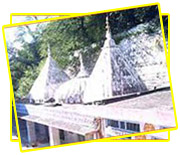 |
|
| |
 |
RANBERESHWAR (Shiv) TEMPLE:The Ranbireshwar Temple is an important itinerary of the Jammu pilgrim tourism. The temple is situated on the Shalimar Road in the city of Jammu. Built in the 19th century, the magnificent temple is flanked throughout the year by the devotees who gather in large numbers to offer prayers to the reigning deity of the temple.
The temple was built by Maharaja Ranbir Singh who is one of the ancestors of the Dogra rulers of the state of Jammu and Kashmir. The temple is dedicated to Lord Shiva who is a part of the holy trinity of the Hindu mythology. The premises of the temple are divided into two halls decorated by images of the gods Ganesha and Kartikeya. The idols of the faithful Nandi Bull is found in the temple.The characteristic feature of the temple is the 7.5 feet tall Shiva lingam that is placed in the main sanctum of the temple. The main limgam rises in the center of the temple and is of black marbled stone. |
|
| |
SHRI RAGHUNATH JI TEMPLE: Wish to visit a temple with lakhs of "Saligrams" (the divine stone of Lord Vishnu) Raghunath temple, dedicated to Lord Rama is a divine place in the heart of Jammu with seven shrines. The most important shrine belongs to the eighth incarnation of Vishnu- 'Rama', who is considered the patron deity of the Dogra community.
The cluster of temples in the nearby area (all dedicated to the Gods and Goddesses related to the epic Ramayana) makes it the largest temple complex in North India. The temple was completed in 25 long years (1835-1860) by Maharaja Gulab Singh and his son Maharaja Ranbir Singh.
Situated in the heart of the city and surrounded by a group of other temples, this temple dedicated to Lord Rama is outstanding and unique in Northern India.The surrounding Temples are dedicated to various Gods and Goddesses connected with the epic Ramayana.The arches and architectural details show Mughal influence. |
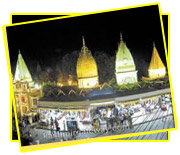 |
|
| |
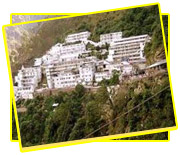 |
MATA VAISHNO DEVI: Katra Town , lying in the foot of Trikuta Mountains , 48 kms. from Jammu, serves as the base camp for visiting the famous holy shrine of Shri Mata Vaishno Devi, which is approachable on foot along a 13 kms long well laid footpath. Every year, more than 4.5 million pilgrims pass through Katra on their holy pilgrimage to the shrine.The cave shrine of Mata Vasihnodevi ji or Trikuta Bhagwati (alt: 5,200 ft.) has been a beacon of faith and fulfillment to millions of devotees from all over the world.The pilgrimage to the Shrine holds great significance for the pilgrims.
The Holy Cave Shrine of Vaishno devi is situated in a beautiful racess of the Trikuta Mountains forming a part of the lower Himalayas as in the state of Jammu & Kashmir at an altitude of over 5000 feet. Popular the world over known as the Moonh Maangi Muradein Poori Karne Wali Mata, which means, the Mother who fulfills whatever Her children wish for, Shri Mata Vaishno Devi Ji resides in a Holy Cave located in the folds of the three peaked mountain named Trikuta (pronounced as Trikoot). |
|
| |
SHIV KHORI TEMPLE: This holy cave situated 100 Kms away from Jammu and 70 Kms from Katra, is nearly a kilometre long with a 4-feet high naturally formed Shivling. It's considered second only to the shrine of Vaishnodeviji according to religious importance. The Holy Cave abode of Lord Shiva is a real wonder to be seen.
The cave is in the shape of Lord Shiva's Damroo i.e. wide at the two ends while very congested at the center.The Shiv-Khori Shrine is well connected to Katra and Jammu by road. The devotees can visit the place by taxi or car. Few bus services from Katra are also available to this divine place. A major festival is held here on the eve of Shivratri every year. |
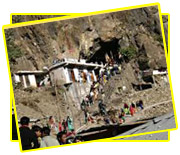 |
|
 |
AMAR MAHAL MUSEUM (Golden Throne Of Maharaja) : Hari Palace Museum and Library, is an epitome of royal grandeur and magnificence.
It is a repository of books and paintings and attracts art lovers and historians from all over the world
Endowed with ethnicity and a soft touch of contemporary art setting, the galleries exhibit the collection of paintings ranging over different styles..
The museum building forms the major part of the majestic Amar Palace, which has a French touch in its architectural style.
he Durbar Hall exhibits the paintings and artworks of the Dogra rulers. The Golden Throne, the major attraction of the museum, is a symbol of great historic significance.
|
|
|